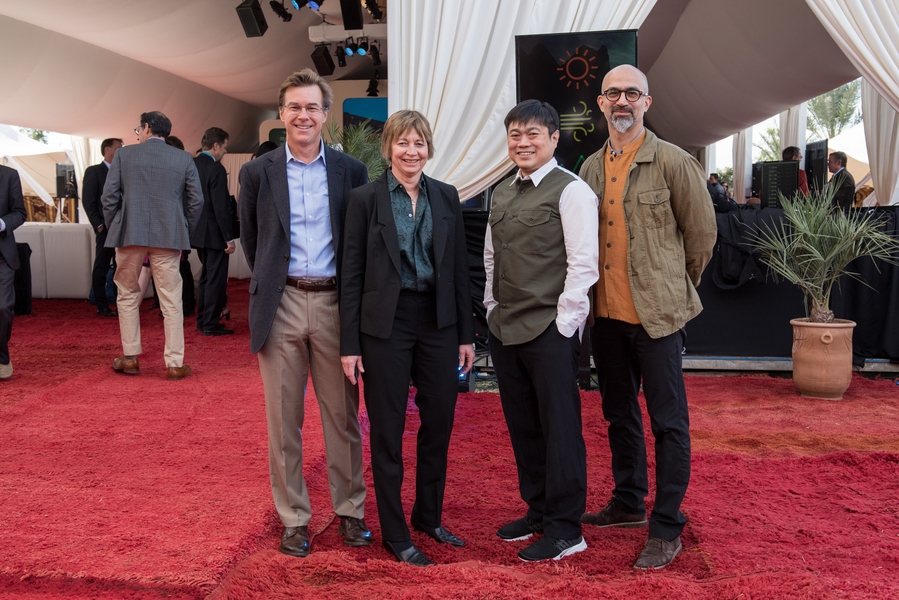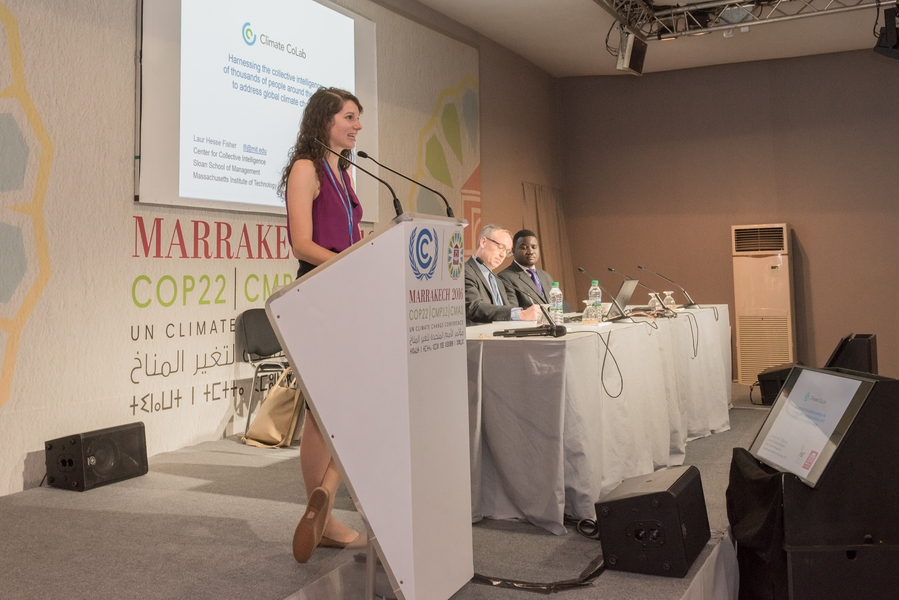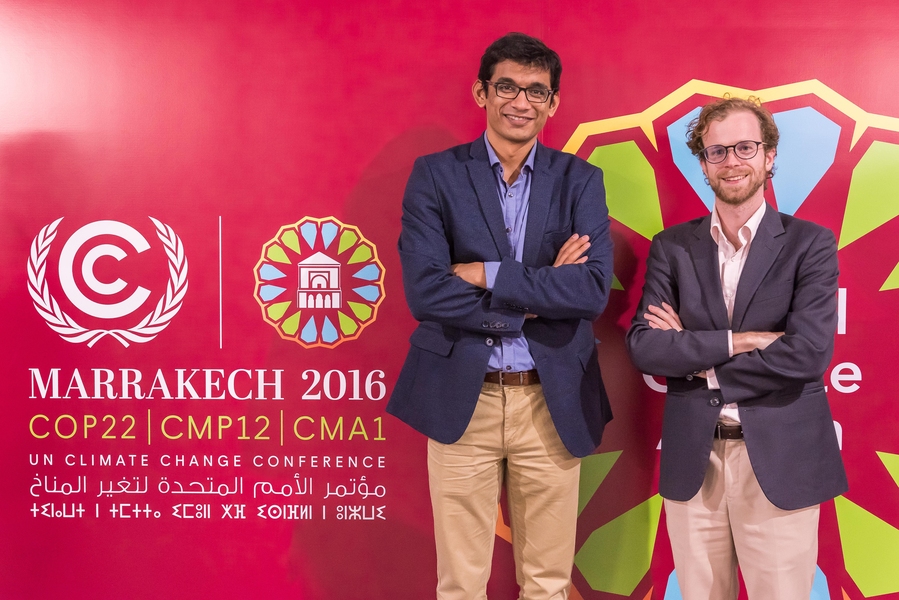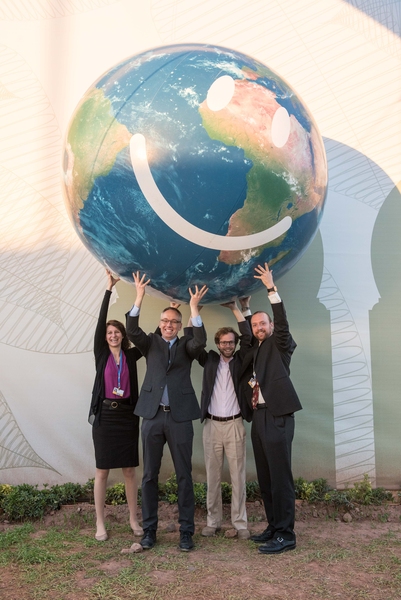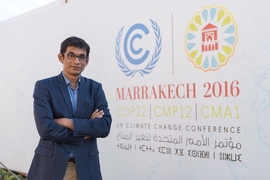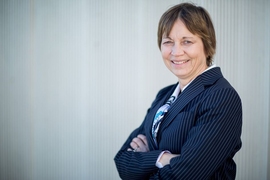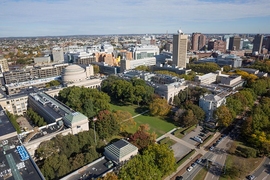Last year, participants in the Paris Agreement on climate change expressed the shared global objective of limiting temperature rise, with each party to the agreement laying out its intended national contributions to addressing climate change. At this year’s UN Climate Change Conference (COP22) in Marrakech, Morocco, as the world wondered what a change in administration could mean for U.S. climate policy and — by extension — the momentum for the Paris Agreement, national and civil society leaders repeatedly expressed their commitment to upholding and advancing implementation of the agreement.
For MIT, the imperative is as clear as ever.
“The Paris Agreement motivated us immensely,” said Maria Zuber, MIT's vice president for research, at a series of conversations hosted by Emerson Collective in Marrakech. “MIT strongly supports the agreement. Collectively, on our campus, we said it is a great starting point — but it’s not enough,” she said.
Zuber spoke with Michael Crow, president of Arizona State University, and Dan Arvizu, Emerson Collective’s chief technology officer and STEM evangelist, on the role of academic research and innovation in meeting global greenhouse gas reduction targets. She went on to describe the Institute’s efforts to conduct research and develop partnerships that foster climate solutions.
These solutions include nature-focused approaches. “Nature-based solutions can play an important part in addressing climate change. Not only can we learn from how natural systems self-regulate, but we can apply that knowledge to designing new technologies and courses of action,” said John Fernández, director of MIT's Environmental Solutions Initiative and a professor of architecture. His initiative is currently exploring partnerships around nature-based climate solutions that protect ecosystems.
At the same event, MIT Media Lab Director Joi Ito discussed the importance of designing systems to solve for multiple problems — such as reducing carbon emissions while also improving quality of life and caring for the environment. “When you think of a complex system like the environment or a city, how do you design for everything in the system so that it’s optimized not just for the one player that has economic value, but for the entire system? That’s the kind of design we need to figure out how to do,” he said, adding: “The people participating day-to-day in the system can be the designers. It’s about bringing science directly into the community and having the community participate in the science.”
Robert Stoner, deputy director of the MIT Energy Initiative (MITEI), expanded on this idea in a breakout discussion on citizen science and education. “The democratization of data with the availability of low-cost measurement technology and access to the Internet creates new opportunities for nonscientists to participate in creating knowledge and using it to improve the world. But [it also creates] potential for that data to be misinterpreted or misused in civil discourse — underscoring the need for scientists to be involved ‘on the playing field’ as interpreters in an ethical and responsible manner,” said Stoner, who is also the director of the Tata Center for Technology and Design.
Crowdsourcing climate solutions
To empower individuals to contribute to climate solutions while employing scientific rigor, MIT’s Climate CoLab has developed a crowdsourcing platform for people around the world to collaborate on creating plans for addressing climate change.
At a COP22 side event with Climate Interactive and the Abibimman Foundation, Climate CoLab project manager Laur Hesse Fisher described the online platform and contests, in which participants devise individual climate policies and actions, and integrated national and global plans. Scientific experts analyze and judge the proposals in terms of projects’ feasibility and potential impacts among other criteria. The winners use prize money to help scale their ideas.
Fisher encouraged audience members to submit proposals for a contest open through February with the United Nations Secretary-General’s Climate Resilience Initiative: Anticipate, Absorb, Reshape (A2R). “We’re running a contest to get your ideas and your projects on how the most vulnerable countries can anticipate the climate hazards that they’re going to face,” she said. “We welcome you to submit your idea so that you can be part of this process.”
Fisher also spoke at an event with the Cities Climate Finance Leadership Alliance to showcase and discuss existing initiatives and practical examples of approaches intended to accelerate climate action at the urban level, and she held several other events to introduce people to Climate CoLab’s platform.
"Climate CoLab shows that new technologies can make new things possible, and that’s what we do at MIT,” said Fisher. “But it’s not only more efficient solar panels or carbon capture technologies — it’s also new ways that the world can work together.”
Sharing interactive climate tools in Africa
Ahead of and throughout COP22, John Sterman, a professor of management at the MIT Sloan School of Management, and Climate Interactive team members have worked to bring their interactive climate policy models and tools to Africa. They have conducted workshops on their jointly developed “World Climate” role play throughout Africa and around the world — including sessions with Moroccan business leaders and university students, staff, and faculty. “We’re enabling local scholars, educators, and members of civil society to help their communities learn for themselves about the international climate negotiations, data modeling, and the urgency of emissions reductions for all nations,” said Sterman.
MIT and Climate Interactive have also created new tools to support “climate smart agriculture” in Africa, led by Climate Interactive’s Travis Franck SM ’05 PhD ’09, who is also an MIT research affiliate.
“Our prototype interactive system dynamics model considers how countries can meet two critical goals: expanding food production to support their growing populations and cutting the greenhouse emissions from the agricultural sector,” said Sterman. He and Franck shared this work in several side events at COP22.
Analyzing nations’ climate progress and choices
Graduate students Arun Singh and Michael Davidson came to Marrakech to advance their international climate research and keep abreast of real-time developments in climate policy.
Davidson, who first attended the international climate talks in 2010, researches China’s climate and energy policies related to renewable energy and the electric grid as a PhD candidate with the Institute for Data, Systems, and Society (IDSS) and a research associate with the Joint Program on the Science and Policy of Global Change. He arrived in Marrakech just before the U.S. election and witnessed uncertainties arising from the outcome globally and around U.S.-China relations, which had warmed leading up to the Paris Agreement last year, with jointly announced climate commitments that were seen as crucial to the adoption of the agreement.
“There are many reasons why it's in the best interests of the U.S. not to withdraw, but now, the big question is, if the U.S. does leave the agreement, who’s going to take up the mantle and drive the implementation process forward? There is a lot of interest in seeing China — but also EU and others — step forward, helping to fundamentally shape the agreement without U.S. input or interests at its center,” said Davidson. He is also examining how the agreement's provisions on tracking countries’ progress toward meeting collective climate goals will take shape, and is among those helping to ensure that it will include robust scientific assessments, working with advisor Valerie Karplus and Henry Jacoby, professors at the MIT Sloan School.
Singh, a master’s degree student with IDSS and a fellow with the Tata Center for Technology and Design, is developing an energy-economic model to help inform India’s climate policies and technology choices. He shared his research at a side event and conducted interviews related to his work as a Tata Fellow and research associate of the Joint Program with advisors Karplus and principal research scientist Niven Winchester.
During COP22, the U.S., China, and Mexico announced their 2050 greenhouse gas emissions targets, with the U.S. and Canada each pledging to reduce emissions 80 percent from 2005 levels by 2050, and Mexico pledging to reduce emissions 50 percent from 2000 levels by 2050. The U.S. released its plan in a new report, the United States Mid-Century Strategy for Deep Decarbonization, which cited research by Jessika Trancik, an associate professor of energy studies with IDSS, on the “virtuous cycle” of continued clean energy technology development and deployment “in which ambition drives down costs, in turn eliciting greater ambition.”
In an analysis of the three nations’ plans, Sterman said, “Our relentlessly shrinking carbon budget means all nations of the world must offer earlier and deeper cuts than they pledged in Paris, and continue to cut emissions through the end of the century. These midcentury strategies should inspire other nations to be even more ambitious. Warming cannot be limited to ‘well below’ 2 C without stronger midcentury commitments from all other nations.”
Committing to continued action
Speaking with news network France24, Sterman reflected on the overarching sentiments at COP22 in the wake of the U.S. election: “The agenda has changed, but what is interesting is that a large number of the parties — the nations here — are asserting that they will continue to reduce their emissions regardless of what the United States may or may not do under the new administration,” he said. “And the civil society groups that are here, representing every aspect of society in the United States and around the world, are committed to redoubling their efforts to build grassroots support for climate action at the community, municipal, and state level.”
At MIT, across the Institute, community members are prepared to keep accelerating climate action in keeping with the Plan for Action on Climate Change.
As Zuber said at the Emerson Collective event, “We can’t just talk about this. We have to lead by example.”
